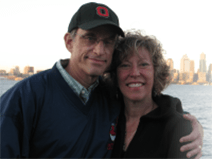The Challenge
Thomas Knox and his wife Lee were on vacation in Yosemite National Park early in 2007 when rangers were performing a planned burn of some underbrush. The smell of smoke was overwhelming to Lee, but Tom didn’t notice it.
Tom, who was 55 at the time, shrugged it off as just another symptom of aging. About a year later, Tom developed some congestion and nasal drainage. After two months of thinking it was just a cold, Lee urged him to see an ear, nose and throat doctor (ENT). The ENT thought it might be a sinus infection and prescribed antibiotics.
"It felt as though a huge weight had been lifted." — Lee
After four weeks Tom’s symptoms didn’t go away. A CT scan revealed esthesioneuroblastoma, a very rare cancer that develops in the upper part of the sinus cavity between the eyes and is believed to arise from tissue associated with the sense of smell.
Schedule an Appointment or Ask a Question
Tom, a Cleveland resident, consulted with local surgeons and then a second institution out of town. Removing the tumor would be difficult due to its location and involvement with the eye, and because it had encroached into an area near the brain.
The surgeon suggested approaching the tumor from above, making an incision across the top of his skull, as well as from below, making an incision on the face along the side of the nose. The surgery would have caused scarring and potential disfigurement to Tom’s face, and because of all the tissues that the surgeon would have to cut through, there was the possibility of permanent nerve damage, brain damage, or both. Tom and his family had reservations and decided to search for alternatives.
The Path to UPMC
Lee was up late researching treatments online when she received two emails – one from each of her sons. They were also online, searching for information about their dad’s tumor. They both had found their way to the UPMC Minimally Invasive Brain Surgery website and shared the information with Lee. Excited about what she read on the Endoscopic Endonasal Approach (EEA), a cutting-edge procedure to remove tumors through the nose that was pioneered by UPMC surgeons, Lee contacted UPMC the next morning. Within a week, Tom and his family got the call they had hoped for.
“One of the doctors called and said ‘Yes, we can treat you.’ We had been desperately searching for answers for several weeks, so hearing those words immediately filled us with hope.”
"The optimism they presented was a significant contrast to the grim picture we were given by the other surgeons. It felt as though a huge weight had been lifted"
The Solution
In April 2009, the surgical team removed the mass and all tissue with microscopic tumor invasion from Tom’s nasal and sinus cavity – using the EEA technique. The defect that was left was reconstructed using unaffected tissue from inside Tom’s nose.
Following surgery, Tom left Pittsburgh to undergo two months of radiation treatments to destroy any remaining cancerous cells. Unfortunately, the radiation damaged the graft, requiring additional surgery to replace it.
“We got the news about the second surgery after a follow-up visit two days before Thanksgiving – not what we wanted to hear,” said Tom.
But the doctors were able to schedule the procedure the next morning and their reassurance and compassion gave us confidence that we would have a positive outcome.
The Results
Tom has been cancer-free for more than two years and has no visible marks from either surgery. His vision was never affected by the surgery, and he is back to work as a sales application engineer.
“It was a miracle given the circumstances. We are so thankful we found these doctors. Their skills with these minimally invasive procedures gave us the best chance of getting through this without any devastating effects,” said Tom. “Both times our doctors said ‘We’re going to get you through it all.’ And they did.”
Our patient stories profile a number of patients who have had minimally invasive brain surgery at UPMC. Although everyone's care experience is unique, we hope that sharing these stories will help other prospective patients and their families better understand these procedures and their potential benefits.
Tom's treatment and results may not be representative of all similar cases.
















